Bicycle vacation Kyrgyzstan
Tien Shan, silver-colored rivers and green meadows
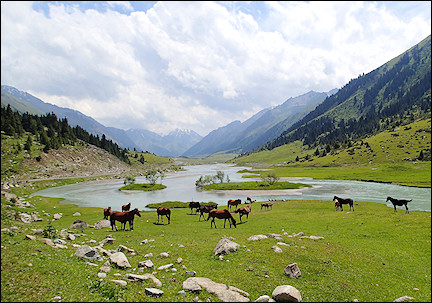
|
A bicycle expedition to Tien Shan, also known as the Heavenly Mountains in Kyrgyzstan. On the worst roads in the world through the most beautiful landscapes. Climbing and descending with views of white mountain peaks (6,000 to 7,000 meters), green valleys dotted with yurts and herds of horses, and crossed by shiny silver-colored rivers. Sleeping in tents, washing and doing laundry in the rivers and squatting over a hole in the ground to relieve oneself. Call it an adventurous bike trip if you want...
Travelogue & photos: Pieter Parmentier
Like a huge snow plough our group of fifteen men and women with bike boxes work their way through the crowds at the airport of Bishkek. Then the boxes are loaded onto a truck and we leave for our hotel.
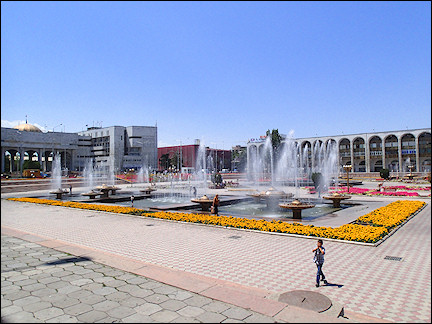
|
The next day we have some time to see this special Central Asian city: there still is a visible influence from the Soviet days, like wide avenues with megalomanic buildings and statues. Fortunately there are also many parks that temper the heat of the summer.
As we are assembling bike parts to make complete bikes, the hotel's garden becomes cluttered with boxes, bags and tools. After this, it's fun to go shopping for the whole duration of our trip: a train of carts, filled with hundreds of rolls of toilet paper, 36 liters of cola, dozens of jars with chocolate paste, cans of meat, bottles of beer and wine and more indispensable stuff.
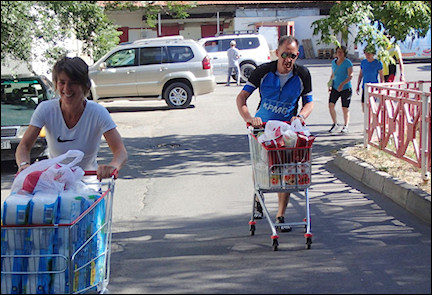
|
Everything is loaded onto a truck; a ten tonner that will accompany us during our trip with our luggage, food, tents and four Kyrgyzian guides. While we are taken from Bishkek through a tunnel to the Tor Ashuu Pass at 3580 meters in the Tien Shan mountains, the bikes are transported on the roof of the truck.
Suusamyr Valley and Kekemerin River
Snowy mountains, screes and meadows as far as the eye can see
Our first kilometers by bike are spent descending the Tor Ashuu Pass; the surrounding landscape is impressive, with in the foreground rolling green meadows and in the background mighty snowy mountains. The meadows of the Suusamyr Valley - into which we descend - are dotted with yurts (felt tents of the nomadic people who live here) and lots of cattle and horses.
We spend the night in a beautiful spot on the bank of the fast-flowing Karakol River. We are supposed to pitch our tents ourselves and we succeed surprisingly well. It shows that we are all experienced travelers. I thought I'd seen quite a lot of the world with trips to Tibet, Peru, Chile, Costa Rica and Zambia, but I feel like a greenhorn in this company.
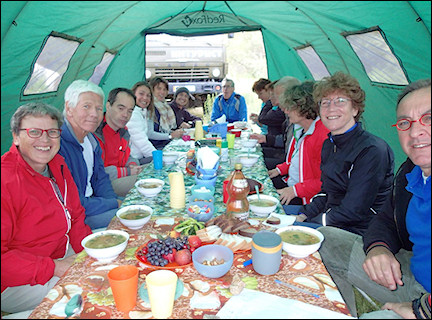
|
Dinner is served in the big tent and we really enjoy the food. We have a lot to discuss and joke about. I have to get used to spending the night in a small tent. Eight years ago in Peru was the last time I did this. It's cold, so I am happy with my down sleeping bag.
We get up at seven AM, have breakfast with omelets at eight and get on our bikes at nine. Today's leg doesn't seem too hard: 61 kilometers, mostly descending from 2100 to 1500 meters. But the roads are washboards; it's a miracle my crowns and fillings stay in place.
David and I share a tent and today we ride in the front, as it were to scout the road. The weather isn't great, it rains every now and then, but it's not cold.
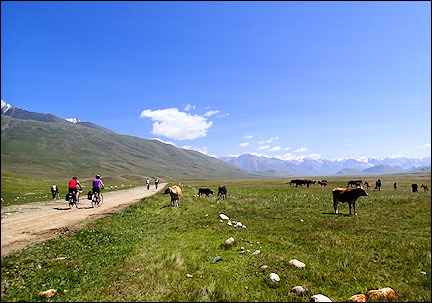
|
We follow the blue-green Kekemerin River and bicycle through a wild landscape with beautiful snowy mountain formations, screes and meadows as far as the eye can see. Along the road grow wonderful wild flowers, like Edelweiss, Echium vulgare and orchids.
Early in the afternoon the ride is over and we make our camp next to the Kekemerin River. It's a pretty spot, but first we have to clear out the beer and vodka bottles and other litter left by other campers. There are many marijuana plants here, so we might have a cozy evening.
Via the Kara Keche Pass to Lake Son Kul
Three times in one day we cross a cold, fast-flowing river
Our trip finally begins to look like an expedition. The distance we have to cover today (68 kilometers) is in and by itself not heroic, but the road leads us upward to the horizon in one straight line, and is also covered with rocks and grit. It's one of the worst roads I have ever bicycled on. I even break a chain; but our guide Niels gets his chain tool and removes the broken links. Fifteen minutes later I can continue on my ride.
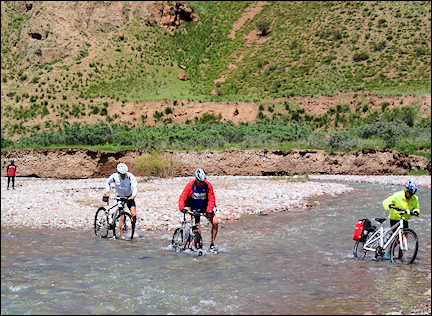
|
On the way we wade through three rivers. They aren't very wide, but cold and fast-flowing. After the last river the truck with our kitchen tent is waiting for us. In the pouring rain we pitch our dome tents in no time at all.
We get drinks with chips and nuts. The bags of chips look as if they are blown up like balloons, because the air pressure is much lower at this height. We drink cold red wine and warm beer from plastic cups. You can't have it all.
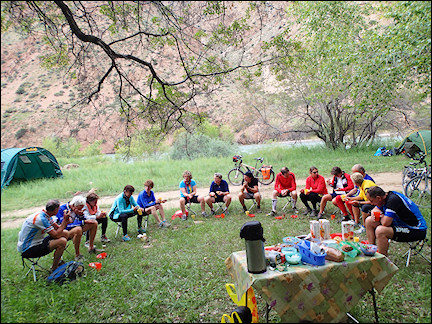 |
There are very different types of people in our group: the relatively quiet ones, the remarkably outgoing ones, people who are almost always happy, the introverted ones and people with leadership aspirations. The oldest one is 65, the youngest 33. An ordinary group, but of the adventurous variety. The atmosphere is good and we laugh a lot. Which is remarkable, considering how much we suffer sometimes during the day.
The long climb to the Kara Keche Pass is wonderful. The weather is great and the road is reasonably okay. At the 3,370 meters high pass we enjoy the view with a cup of coffee. For the first time we see Lake Son Kul, surrounded by a magnificent backdrop of mountains.
The first part of the descent is easy. Until there's a completely unexpected thunderclap, followed by a nasty hail storm. The road becomes a mud pool. The first group can only continue bicycling.
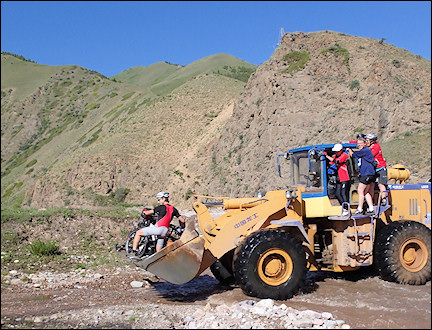
|
For lack of bridges we often have to cross streams and rivers by bike or on foot. This is always good for interesting spectacles. One group looks for another place to cross, others first don their watertight shoes and a group of ladies who arrive late, cross the river by bulldozer, which happens to be around.
Our truck is parked near two yurts by Lake Son Kul. We enter quickly. There are carpets and mattrasses, but nothing to warm up. It will take over two hours before the tents are pitched and we can change into dry clothes.
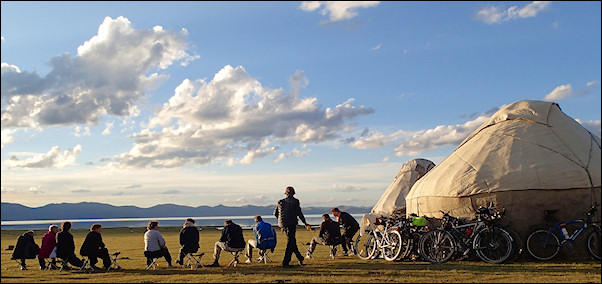
When the sun breaks through the clouds, it's immediately warm. But why are we complaining at all? Two hundred days of the year there is snow in this valley and temperatures can drop to -40 degrees Centigrade. Interestingly, the second group of bikers did not encounter a hail storm, so there is nothing for them to complain about. Or it should be the flees, which are having a bloodfest in the yurt.
In this area the yurts stand far apart from one another. Sometimes they look deserted, but often there are horses and cattle by them. Or a car, which looks strange in these surroundings. People wave and laugh at us, I guess we look funny to them. The other way around it's sometimes the same. Lots of men wear strange hats here.
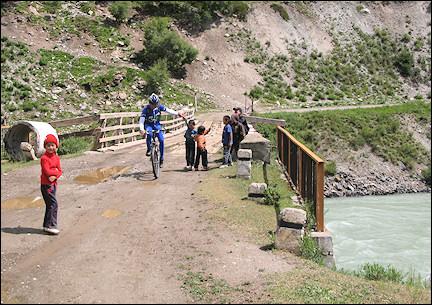
|
The family who lent us their biggest tent today, lives here part of the year. And you can see why: the view is fantastic and there is so much freedom here. Just like in other regions, the children come to have a look at us and they greet us friendly. They are nice people.
It's not clear to me what they eat, even though it's likely that mutton, tea and horse milk will be on the menu. On the way here I saw bags of little white balls for sale. It's probably some kind of mozzarella.
On our own daily menu is hearty food: fresh vegetables, meat or canned fish, noodles, potatoes, soup and warm porridge for breakfast.
Crossing the Moldoo Ashuu Pass into the Kurtka Valley
It's as if the donkey is braying in our tent at night
The bright sunlight in the morning helps us forget about the night. The hard ground and uncomfortable pillow are hard to get used to and the sounds of the animals are nice and rustic during the daytime, but annoying at night.
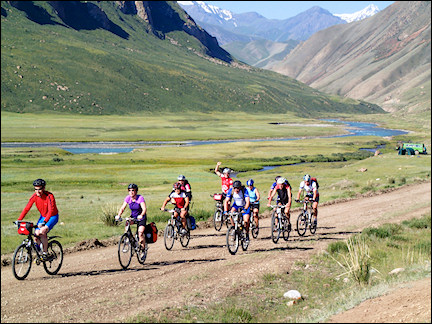
|
At a distance of 50 meters there's a flock of sheep and goats, herded together last night and noisily watched over by dogs. The donkey was braying heartbreakingly in our tent. At least that's what it sounded like. Yesterday there were two donkeys and now one of the dogs is chewing on a donkey leg all day long.
Today's leg is short, only 36 kilometers, but rather difficult. The climb to the over 3200 meters high Moldoo Ashuu Pass is rewarded with a fantastic view and cell phone range. And the descent that follows is the most beautiful in years. Over twenty kilometers we hobble down. The beauty is not in the paving but in the surroundings.
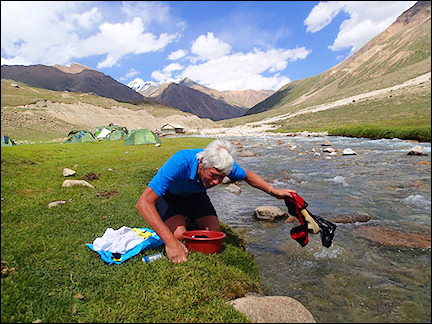
|
Down in the Kurtka Valley we have to cross a river and the first group reaches the green meadow that will be our sixth camping spot already at noon. We have to clean up the junk that other left and then we have a great camping ground. But - as usual - there are lots of turds, so we have to steer around those.
It's a relaxed afternoon, with only lots of chores that need to be done on a trip like this one. But we also talk and relax in the shade. Yesterday we were freezing, and temperatures dropped below zero at night. Not much chance for that today, because we are a thousand meters lower. Some stay in the sun longer than is good for them.
Naryn
Up and down along the wild Naryn River
We haven't encountered biting dogs or dangerous traffic so far. But it's a problem that the traffic rules apparently are free for interpretation. Cars and trucks often drive on the wrong side of the road. They aren't used to bicycles either, so we have to be alert at all times.
The food from the kitchen tent is not always "worth a detour", but it's healthy and nutricious, and often even tasty, especially when you consider the circumstances under which it is cooked. We aren't lacking for anything.
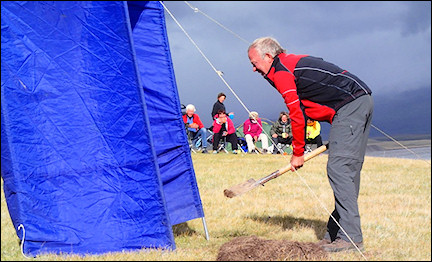
|
That is probably different for the population here, even though they look healthy enough. In the almost deserted areas we travel through, the herds are the nomads' livelihood. So their foods probably lacks in variation. The average annual income here is 350 euros.
We are on the way to the town of Naryn. We haven't seen other towns in days. It rains most of the time, but the road is asphalted and we have the wind in our backs.
The hot shower in Naryn scores high in my list of pamper moments. After a week of washing up in rivers and the pouring rain today, we really need this. You could call it "loss of decorum" and that's what it is: we don't wash up every day, we wear filthy clothes and do our business on the side of the road or in a tent over a hole in the ground. But we aren't overly bothered by this.
Our lodgings in Naryn are not in a hotel but in a few apartments where usually families live. There even is a washing machine which we use with glee. That also goes for furniture, like real chairs, and the wall sockets which are soon taken to charge our cell phones.
In the next couple of days we will ride from Naryn to the gigantic Lake Yssyk Kul and Tien Shan or the Heavenly Mountains. To get there, we will have to cross some challenging passes.
At six in the morning we get three fried eggs each and one hour later we are on our bikes. As we should, because our day trip of almost a hundred kilometers will take nine hours in this terrain.
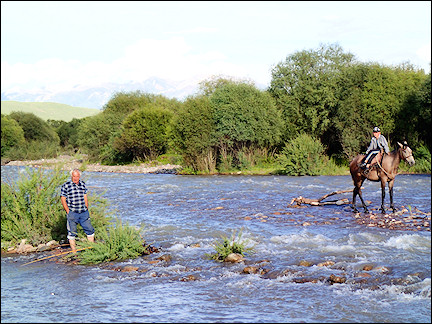
|
It is a bright day and the landscape is also more attractive than the one we crossed yesterday. Wide glacier valleys without glaciers are interesting, but tend to get boring after a while. So this Austrian-like alpine landscape is a nice change of scenery. We ride close to the wild Naryn River, up and down over hills. On the way I see a huge alpine marmot.
By four in the afternoon I am the first one to arrive at our truck. I immediately pitch my tent. The camping spot is beautiful: a fast-flowing stream, panoramic views, green meadows where horses roam free, and mountains, lots of mountains.
Today we have to wash ourselves and our bikes in the stream. The road was muddy, so everything got dirty. It's a miracle no one is sick yet. At least, if you don't count the insect bites, sore butts, minor accidents, etc. The protective layer of filth may help to shield us from worse.
To the Tosor Pass
We climb to the pass, among marmots and horse herds
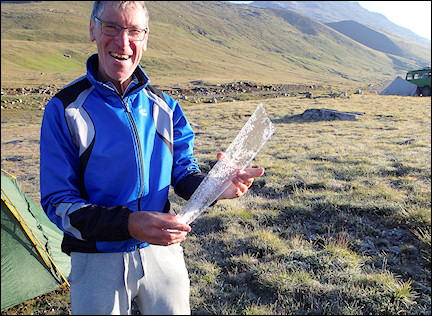
|
There is ice on my washbasin, but when the sun rises, the temperature feels nice immediately, even though it's only 6 degrees Centigrade. The horse herd has disappeared behind the horizon. We have almost covered half of the distance and heights of this trip. And the surroundings keep getting prettier.
Everyone was exhausted yesterday, so we don't complain about the short, easy ride we have today. On the way we see some herds with their cowboys, horse boys and sheep boys: nice pictures.
We arrive early, 12:30 PM at our next camping ground. The light-blue river is at a distance of five meters from my tent. At both ends of the green valley we see snowy mountain peaks and above them a blue sky with white clouds.
It's a short, demanding and beautiful ride up a mountain with constantly changing scenery. There are marmots everywhere. One moment we see herds at a great distance, the next we are riding between them. There are no people, except for a few on horseback, among whom a kid who wants to race me... and he wins, of course: this terrain is so much more suitable for horse riding.
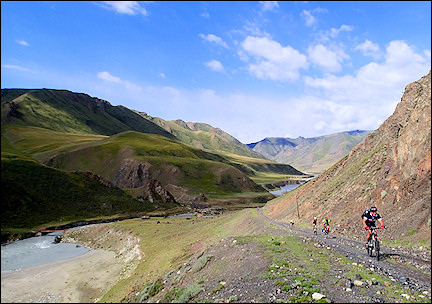
|
The road is so-so and sometimes really bad. Many bridges are missing. Sometimes we can cross a river by bike and sometimes that isn't possible, as we find out when David makes a spectacular fall in a brook. Fortunately he practiced judo when he was young and knows how to fall safely.
We pitch our tents at a few kilometers from the Tosor Pass, which is with its 3,893 meters the highest on this trip. It's kind of cozy to sit in your tent while thunder rages over the mountains, a nasty hailstorm whips the tent and you yourself are warmly dressed and well-fed.
To Lake Yssyk Kul
Alternating stretches of fast and difficult descent
A centimeter of ice on my washbasin. It must have been rather cool tonight outside my sleeping bag. But the sun is already shining when I get up.
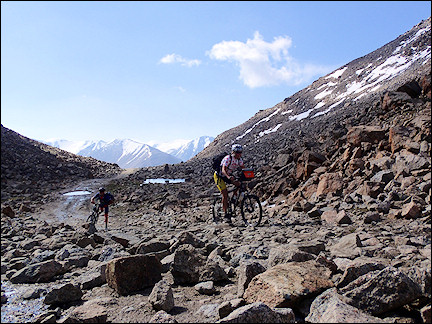
|
The last kilometers of the climb to the Tosor Pass are the hardest ever. The road is not really suitable for biking, what with the wet sand, countless stones and rocks, the sharp incline and little oxygen in the air.
After we cross the pass, the most interesting descent you can imagine follows: fast and easy stretches alternate with difficult ones. And all of this in an ever-changing landscape, towards the famous Lake Yssyk Kul.
On the way the first group finds a nice meadow to sit down on and wait for the others. But what's taking them so long? It turns out there were several falls, one of which was serious enough to bring in the "medical staff". David fell on his shoulder, he can't bicycle anymore and so his trip is over. David gets in the truck and his flight back and insurance are taken care of.
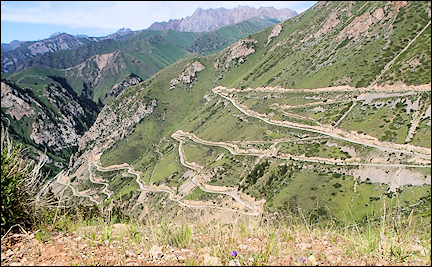
|
The others who fell "only" have scratches, so they can continue on their trip. The atmosphere in the group hasn't suffered from the incidents; there is much empathy. We take a look at the plans for the coming days: now we will really enter the Heavenly Mountains.
Lake Yssyk Kul is large enough (170 x 70 kilometers and 700 meters deep) that you can hardly see the other side. I hope there will be an opportunity to test the temperatue of the thermal swimming water in the lake. The temperature of the water in the shower of my hotel room is nice in any case.
Sary Jaaz Valley
On an inaccessible road from nowhere to nowhere
The climb to the Chon-Ahuu Pass (3,822 meters) is constant and the road is okay, the same goes for the descent. The last ten kilometers lead along a river in the Sary Jaaz Valley; for the passengers in the truck the river is way too close for comfort. The path is in places not even wider than the truck.
For days now we have seen herds of sheep, cows and horses graze the valleys. Sometimes watched over by a shepherd on horseback, but also on their own. At some point they will be retrieved by one of those horsemen, sometimes helped by a dog. This is what life is like here during the summer.
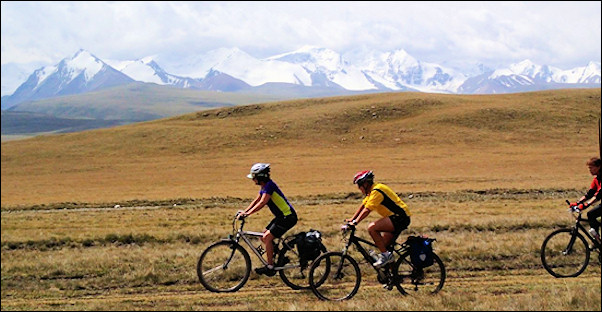
Now and then we see a yurt or a little house, but they are the only reminders of the civilized world here. Which isn't surprising, as the road is all but inaccessible for any means of transportation, except for horses or bikes. You would be right to wonder why this road was ever build, because it leads from nowhere to nowhere. Probably for some strategic reason. We are very close to the Chinese border here.
A relaxing ride on a rolling path along the river. Actually, it's more like a cart track. The views are unparalleled. Only now we can see Tien Shan, the Heavenly Mountains, a long row of six- and seven thousand meters high peaks from horizon to horizon. Huge amounts of snow fill the glaciers and the rivers. This is panoramic in a superlative way.
Our camping spot for today and tomorrow beats everything in this sense. Not in other senses. You have to be lucky when it comes to weather. Initially all is well and everyone does their chores, until the sky gets dark and the wind increases in force.
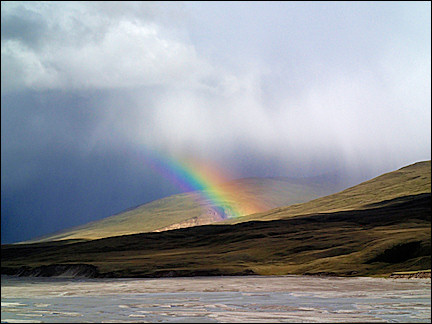
|
Extra tent pegs seem to help, until the storm arrives in full force. The dinner tent, the kitchen tent and the toilet tent are about to fly off. We get stones from everywhere to weight down the tents. Just before the rain begins, we flee to the dinner tent, from which we enjoy two beautiful rainbows. We made it.
Even though we expected our tent to be blown away, last night in our sleeping bags, we stay on this spot. The men of the assistance team are already busy making more tent pegs. This morning, the hills around us are white.
What to do on a day of rest in this unparalleled landscape? Well, riding our bikes, of course! Rien and I explore the Sary Jaaz Valley by bike, the others go on foot. Again it turns out that bikes are the perfect means of transportation here, as we almost effortlessly follow the cart track up river.
We see two farmhouses on our 50 kilometers ride and a gigantic glacier. That is probably the Semyanova glacier, which is part of one of the largest glaciers in the world, the Engilchek. A drawback of glaciers is that they are so large that they are always farther away than they seem to be. Unfortunately we don't have time to get there.
On the way back we find the head of a dead capricorn. After four-and-a-half hours we are back in our base camp, satisfied with our expedition. We receive a warm welcome with warm water. We are cold because of the rain.
To Lake Yssyk Kul
Both humans and bikes long for the end of the trip
Some of us are discouraged this morning. After a clear night with a beautiful starry sky, it's hard to open the tent from the inside. This because the tent has been turned into an igloo, frozen stiff.
After our morning bowl of porridge we wade through the brook and then have to climb to 3,500 meters. It's still freezing cold. The threatening clouds turn out to be false alarm: the weather improves and as we descend, it gets warmer. I see another capricorn head. How many of these animals are or were here?
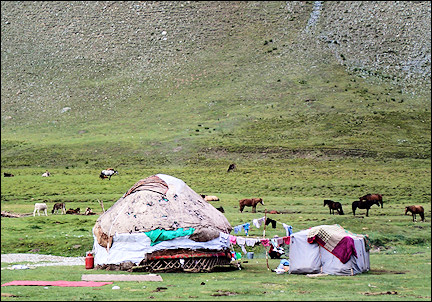
|
We see a huge bird of prey (probably an Eastern imperial eagle) and countless marmots. As they stand there, they look like little men in fur coats, with their hands in their pockets. As we approach, the leader lets out a loud squeak and only after the others are in safety, he disappears in a hole himself.
We ride close to the border with Kazakhstan and leave the Tien Shan, the Heavenly Mountains, behind us. Tomorrow will be the last leg on our trip. It will end at a camping ground by Lake Yssyk Kul. The chain of my bike broke again today and Sikko bicycles with one leg: a problem with a crank. Both humans and bikes are longing for the end of the trip.
In terms of scenery this country is incredibly beautiful, but after two weeks the hardship is taking its toll: the freezing cold nights, washing ourselves in rivers, defecating over a hole in the ground, very limited contact with home because our cell phones usually don't have range, all kinds of vermin, cattle turds and other dirt on most camping spots, Nescafé instead of real coffee, cold feet, sleeping on hard surfaces, meat and fish from cans, stools instead of chairs, etc. We get a lot in return, but that is something you don't always consider.
The last leg is easy, a descent on real asphalt. Well, partly. I have never had so many terrible roads as on this trip. It takes a lot of focus and steermanship.
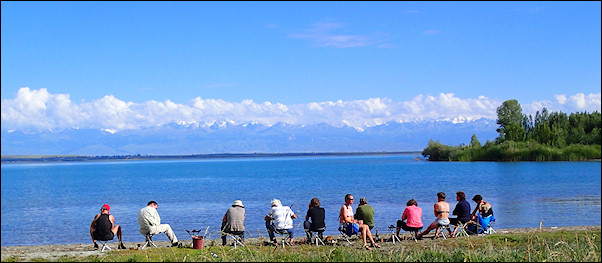
It was hard, but we have reached our destination by bike: the beach of Lake Yssyk Kul. We sit on stools in the sand by the impressive lake. Behind are more mountains with snowy peaks. I guess these are the Kungöya Mountains.
It's a special feeling to call home from the beach and have a perfect connection. For days we couldn't be in touch with our loved ones at all, not even in case of emergency and I didn't like that at all. In the past, it took a month to get an answer to your air mail letter from Zambia. But we got too impatient for that...
We have bicycled almost 900 kilometers in sixteen days, climbing and descending between 1,600 and 3,900 meters, temperatures between 20 and minus 10 Centigrade, hail-, rain and thunderstorms, but mostly good weather for bicycling. It was an impressive expedition through unrivaled landscapes. And we have only seen a part of Kyrgyzstan.